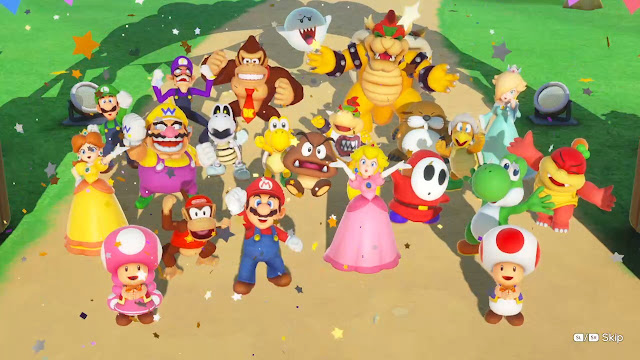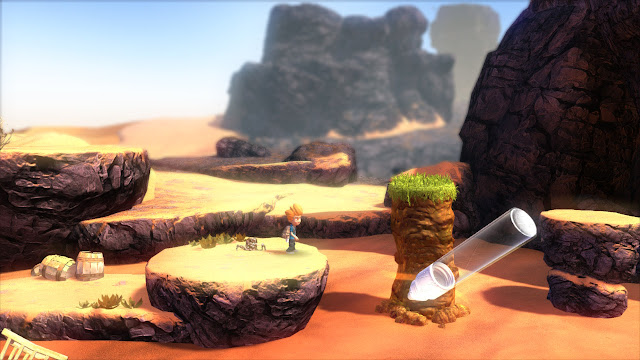Our next review for the month of October is for a game in one of my favorite franchises in video games. It's Mega Man 11, and you can see why I enjoyed the Blue Bomber's latest with my full review.
Gears of War: 20XX
In the '90s and early 2000s, there were two things that were absolute: death and Mega Man games. You couldn't go a month or two without a new release in one of the Blue Bomber's many sub-series, whether in the Classic line, X line, Zero line, Battle Network line, etc. Then, poof! The series was gone from gaming for--at least in this reviewer's opinion--way too long of a time. But, perhaps this extended vacation was worthwhile after all, because with the latest in Classic series, Mega Man 11, the developers at Capcom have reinvigorated the series with a fresh new gameplay hook.
 |
| Dr. Wily is an old scientist, but he's back with some new tricks. |
Yes, one of the things that got to me about Mega Man games was that they were getting a bit stale gameplay-wise. There were small incremental upgrades introduced to the series in a piecemeal basis, such as Mega Man 3's slide and Mega Man 4's Charge Shot, for instance. Meanwhile, Mega Man 11 finally adds something that fundamentally changes the gameplay with a feature that completely altered the way I took on stages and bosses: the Double Gear system.
Apart from being tied to the story of Mega Man 11, the Double Gear system allows players to use the left and right shoulder buttons to power up Mega Man's attack or slow time down respectively. When used, Mega Man can make short work of foes, and with his Power Gear, he can even super charge his special weapons taken from defeated Robot Masters. Meanwhile, the Speed Gear is perfect for a twofold reason: 1) It can give the player more time to react to oncoming obstacles, hazards and attacks, such as Torch Man stage's encroaching instant-death wall of flames that pursues Mega Man; and 2) It can grant Mega Man the ability to shoot off more shots from his Mega Buster while time is slowed down, enabling him to take out enemies and bosses in a faster fashion.
 |
When the Power Gear is activated, special weapons like this
one of Block Man's fall down on enemies like a ton of bricks. |
However, you can just spam either of the two gears making up the Double Gear system. As you use a gear, a meter builds energy. If it fills completely, Mega Man overheats--being more vulnerable to damage and shooting with less attack power. This weakened state lasts for several seconds, but in an all-out battle against one of Mega Man 11's multiple bosses, it can put you at a serious disadvantage at the exact wrong time.
Speaking of boss battles, Mega Man 11's bosses all utilize the Double Gear system in one way or another. For the Robot Masters, each of the eight bosses utilize either the Power Gear or the Speed Gear mid-fight to unleash a seriously devastating move or series of attacks--usually when their health has gone done at least halfway. For instance, while Bounce Man's... well, bounces across the screen occur at a much speedier pace with his Speed Gear activated, Block Man turns into a giant golem with his own set of attacks when he turns on his Power Gear.
 |
| Mega Man hopes to permanently pull the plug on Fuse Man. |
The eight Robot Masters in Mega Man 11 themselves are some of my favorites in series history. Not just with their designs, but their attack patterns and personalities as well. The latter are represented well by both the charming voicework in the game and their aforementioned designs. As an example, Tundra Man is designed with a championship figure skater in mind, and all of his attacks implement that kind of ideology. It skates, spins, and speeds across the icy battlefield in Mega Man's encounter with the enemy, and the colorful dialog only helps accentuate the various bosses' personalities even more.
Not just the Robot Masters, but the special weapons that Mega Man obtains from defeating each and every one of them. All eight have their uses while outside of boss fights. Generally, in games like Mega Man 2 or Mega Man 9, there was really just one really great weapon to use throughout levels. In Mega Man 11, the different functions of each weapon helps in a multitude of situations, so you're never really relying on just one or two special weapons at once. Moreover, it's a godsend to be able to switch between weapons with movement from the right analog stick, and even more so by having the Rush Coil and Rush Jet assigned to two of the face buttons instead of having to select them from the pause menu.
 |
| It wouldn't be a Mega Man game without Sniper Joe dropping by for a visit. |
As for the designs of levels, Mega Man 11 is relatively straightforward, offering extremely linear areas and rooms. There are no secret areas to be found, which is a bit of bummer, as I did enjoy hunting down collectibles in Mega Man 5, Mega Man 7, and of course, Mega Man 8. That said, this approach to the level design means it's less about superfluous content and more about no-nonsense, straight-up, get-to-the-boss action. Whether you're bouncing around the balloon walls, ceilings and floors of Bounce Man's stage (just remember to hold down the jump button to consistently bounce up high), or dodging spikes in the underwater currents of Acid Man's stage, each level in Mega Man 11 has its own feeling to it, and all of them I enjoyed.
 |
| These hazards are simply wanting to give a "hand" to Mega Man. |
While Mega Man 11 does lack any sort of collectibles in levels, the game does offer a great deal of replay value regardless. There are four difficulties total in Mega Man 11, and not only does this present players of all skill levels an adequate challenge, but a fair amount of in-game achievements revolve around completing these difficulties with different objectives. It could be something as simple as beating the hardest difficulty mode (the one where levels do not house health or energy-recharging items, nor do the enemies drop them), completing the game without purchasing any ability-boosting chips from Dr. Light's Lab, or beating the game in an hour or less.
 |
| Fuse Man's stage is full of these electrodes looking to bring a shock to the Blue Bomber's system. |
Additionally, Mega Man 11 has a category of modes called Extra Modes. Here, you can check out completed achievements, gaze at the character gallery, or take on challenges of varying types in each of the eight Robot Master stages. These range from simple time trials to more complex challenges where you try to complete the level with as few jumps as possible, with as few enemies destroyed as possible, or as few red balloons popped as possible. These do get somewhat repetitive playing the same stages over and over again with unique challenges, but it's an option there for those who want to compete against the world on the game's leaderboards.
Of course, all of this would not be worth a bolt if Mega Man handled like he was rusted and ready for the scrapyard. Thankfully, Mega Man 11 feels great when it comes to controlling the Blue Bomber, no matter the level and no matter the surface. Perhaps the only real issue I have is how much time it takes for Mega Man to recover upon taking damage. There's a slightly longer delay for Mega Man to return from his stunned form than in other games in the series. This occasionally resulted in me taking some rather frustrating deaths from getting hit and then falling into a bottomless pit. Still, that was mostly in the early goings of my more than 10 hours of play time with Mega Man 11. (And no, it didn't take 10+ hours just to beat the game once. I played through the game more than five times on various difficulties.)
 |
| The only one having any amusement in this park is Blast Man! |
Mega Man 11 looks exceptional visually, in my eyes. The backgrounds are mixed between highly detailed at times to drab and almost unnoticeable other times. The models of characters and enemies look sharp and detailed, though Mega Man's running animation does little to not make him look like a dork, as it looks just a
bit off. Furthermore, and something that every Mega Man game until 11 has gotten right--the Blue Bomber in Mega Man 11 drops to the ground if you jump into a boss door instead of coolly floating in air as he passes through it. What in Rockman World is up with that!?
 |
| Mega Man deftly dodges this duo of pickaxes. |
In more important gripes with Mega Man 11's presentation, while the sound effects and voicework are rather nice, the music isn't so much. It's nothing to do with the composition or the melodies--it's more to do with how the music sounds thanks to the dubious instrumental used. I vastly preferred hearing the DLC's jazzy version of the soundtrack--even though it only spanned the eight Robot Master stages. Unfortunately, the DLC with this music was only available by pre-ordering Mega Man 11 and only from select retailers. I can only hope that Capcom eventually allows those who purchased the game late to have access to this music, as it made all the difference to me. And, darn are those tracks catchy!
Mega Man 11 shows the Titanium Titan in one of his greatest adventures yet. The platforming is overall tight as ever, as is the level design that returns to a no-nonsense, no-filler philosophy, which makes for a leaner and meaner gameplay experience. The means with which you can customize your experience with the various difficulties and helpful items in the game's shop allows Mega Man 11 to be enjoy by all ages and skill levels. While I didn't care much for the base music (and even then it's not horrid by any stretch of the imagination), the rest of the presentation--from the story that explores Dr. Light and Dr. Wily's university days, to the slick graphics and voicework--more than delivers. The Blue Bomber is back, and hopefully this time it's for good. And if not that, then for everlasting peace!
[SPC Says: B+]

















































